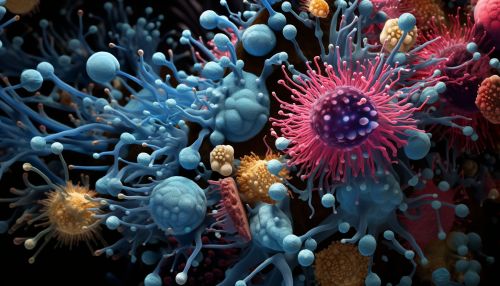Pathogens
Introduction
Pathogens are microbial agents that cause disease in their host. The term is often used to refer to infectious agents such as viruses, bacteria, and fungi. These organisms have evolved various strategies to invade and exploit their hosts for their own survival and reproduction.
Classification of Pathogens
Pathogens can be classified into several types based on their biological nature, the diseases they cause, and the mechanisms they use to infect hosts.
Viruses
Virus are small infectious agents that can only replicate inside the cells of a host organism. They are composed of genetic material (either DNA or RNA) enclosed in a protein coat. Viruses can cause a wide range of diseases, from common colds and flu to more severe conditions like HIV/AIDS and Ebola.
Bacteria
Bacterial pathogens are single-celled organisms that can cause diseases such as tuberculosis, cholera, and syphilis. They can be classified based on their shape (cocci, bacilli, or spirilla), their response to Gram staining (Gram-positive or Gram-negative), or their oxygen requirements (aerobic or anaerobic).
Fungi
Fungal pathogens can cause diseases like ringworm, athlete's foot, and candidiasis. They can be unicellular (like yeasts) or multicellular (like molds). Fungi can infect various parts of the body, including the skin, nails, and respiratory tract.
Prions
Prion are infectious proteins that can cause neurodegenerative diseases like Creutzfeldt-Jakob disease and kuru. Unlike other pathogens, prions do not contain any genetic material.
Mechanisms of Pathogenicity
Pathogens have evolved various mechanisms to invade and exploit their hosts. These mechanisms include adherence to host cells, invasion of host tissues, evasion of the host's immune response, and production of toxins.
Adherence
Many pathogens have special structures called adhesins that allow them to adhere to the surface of host cells. This is often the first step in the infection process.
Invasion
Some pathogens can invade host tissues, either by producing enzymes that degrade the host's defenses or by tricking the host's cells into engulfing them.
Immune Evasion
Pathogens have developed various strategies to evade the host's immune response. For example, some bacteria can change their surface proteins to avoid recognition by the host's immune system.
Toxin Production
Many pathogens produce toxins that can damage host tissues and disrupt normal cellular functions.


Host-Pathogen Interactions
The interaction between a host and a pathogen is a complex process that involves many factors. The outcome of this interaction can range from asymptomatic carriage of the pathogen to severe disease and death.
Immune Response
The host's immune system plays a crucial role in controlling and eliminating pathogens. The immune response involves both the innate immune system, which provides a rapid but nonspecific response to pathogens, and the adaptive immune system, which provides a slower but highly specific response.
Pathogen Adaptation
Pathogens can adapt to their hosts in various ways. For example, they can evolve resistance to the host's immune response or to antimicrobial drugs.
Co-Infection and Superinfection
A host can be infected with more than one pathogen at the same time (co-infection) or can be infected with a new pathogen while still recovering from a previous infection (superinfection).
Prevention and Control of Pathogenic Diseases
The prevention and control of diseases caused by pathogens involve various strategies, including vaccination, antimicrobial therapy, and public health measures.
Vaccination
Vaccines are one of the most effective ways to prevent infectious diseases. They work by stimulating the host's immune system to recognize and fight off specific pathogens.
Antimicrobial Therapy
Antimicrobial drugs can be used to treat infections caused by pathogens. These drugs can either kill the pathogen or inhibit its growth.
Public Health Measures
Public health measures such as sanitation, hygiene, and surveillance can help prevent the spread of pathogenic diseases.
